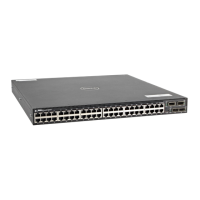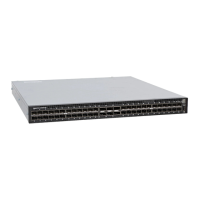Synchronization between Management and
Standby Units
Data between the Management and Standby units is synchronized immediately after bootup.
After the Management and Standby units have done an initial full synchronization (block sync), Dell
Networking OS only updates changed data (incremental sync). The data that is synchronized consists of
configuration data, operational data, state and status, and statistics depending on the Dell Networking OS
version.
Forcing an Stack Unit Failover
To force an Stack unit failover, use the following command.
Use this feature when you are replacing a stack unit and when you are performing a warm upgrade.
• To trigger a stack unit failover.
EXEC Privilege mode
redundancy force-failover stack-unit
Example of the redundancy force-failover stack-unit Command
Dell#redundancy force-failover stack-unit
System configuration has been modified. Save? [yes/no]: yes
Proceed with Stack-unit hot failover [confirm yes/no]:yes
Dell#
Specifying an Auto-Failover Limit
When a non-recoverable fatal error is detected, an automatic failover occurs.
However, Dell Networking OS is configured to auto-failover only three times within any 60 minute period.
You may specify a different auto-failover count.
To re-enable the auto-failover-limit with its default parameters, use the redundancy auto-failover-
limit
command without parameters.
• Set a different auto-failover count.
CONFIGURATION mode
redundancy auto-failover-limit
• Re-Enable the auto-failover-limit with its default parameters.
CONFIGURATION mode
redundancy auto-failover-limit
(no parameters)
High Availability (HA) 420

